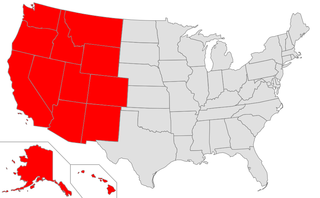| Western American English | |
|---|---|
| Western U.S. English | |
| Region | Western United States |
Early forms | |
| Dialects | |
| Language codes | |
| ISO 639-3 | – |
| Glottolog | west2920 Western American English |
 States where Western American English and its dialects are spoken | |
Western American English (also known as Western U.S. English) is a variety of American English that largely unites the entire Western United States as a single dialect region, including the states of California, Nevada, Arizona, Utah, New Mexico, Colorado, and Wyoming. It also generally encompasses Washington, Oregon, Idaho, and Montana, some of whose speakers are classified additionally under Pacific Northwest English.
The West was the last area in the United States to be reached during the gradual westward expansion of settlement by English speakers and its history shows considerable mixing and leveling of the linguistic patterns of other regions. Therefore, since the settlement populations are relatively young when compared with other regions, the American West continues to be a dialect region in formation.[1] According to the 2006 Atlas of North American English, as a very broad generalization, Western U.S. accents are differentiated from Southern U.S. accents in maintaining /aɪ/ as a diphthong, from Northern U.S. accents by fronting /u/ (the GOOSE vowel), and from both by consistently showing the low back merger (the merger of the vowel sounds in words like cot and caught).[2] Furthermore, in speakers born since the 1980s, the related low-back-merger shift has been spreading throughout the Western States.[3] The standard Canadian accent also aligns with these defining features, though it typically includes certain additional vowel differences.
- ^ Busby, M. (2004). The Southwest. The Greenwood encyclopedia of American regional cultures. Vol. 8. Greenwood Press. pp. 270–271. ISBN 978-0-313-32805-3. Retrieved August 29, 2014.
- ^ Labov, Ash & Boberg (2006), p. 146.
- ^ Becker, Kara (2019). Introduction to "The low-back-merger shift: Uniting the Canadian vowel shift, the California vowel shift, and short front vowel shifts across North America". Publication of the American Dialect Society, 104.
